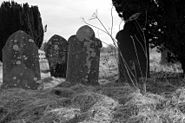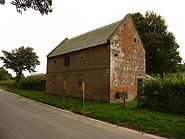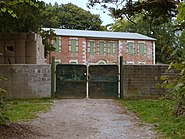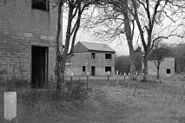| Imber | |
|---|---|
| Population | 0 |
Imber is an uninhabited village in part of the British Army's training grounds on the Salisbury Plain, Wiltshire, England. It is situated in an isolated area of the Plain, about 2.5 miles (4 km) west of the A360 road between Tilshead and West Lavington. The entire civilian population was evicted in 1943 to provide an exercise area for American troops preparing for the invasion of Europe during the Second World War. After the war villagers were not allowed to return to their homes. The village, which is still classed as a civil parish, remains under the control of the Ministry of Defence despite several attempts by former residents to return. Non-military access is limited to several open days a year.[1]
History[]
Early history[]
Settlement in the area began before the period of Roman rule, in the British Iron Age or earlier. Several ancient trackways lead to and from the village. The first documentary evidence of Imber's existence comes from Saxon times, with a mention of the village in 967. Imber is also recorded in the Domesday Book, at which time it is believed to have had a population of around fifty. The village's church of St Giles dates from the 13th century and has notable wall-paintings from the 15th. By the 14th century the population of the village had risen to around 250, where it is believed to have remained until the 19th century. Population peaked at 440 as recorded in the census of 1851, declining to around 150 by the time of Imber's abandonment.
Imber was always an isolated community, Salisbury Plain being relatively sparsely populated, and most of its residents were employed in agriculture or work that directly depended on it.[2] The village had an elongated form like a linear village, and its main street followed the course of a stream known as Imber Dock. The only building to survive in a reasonable condition is the church, with the rest becoming derelict or demolished by the Army. In 1943 there was also a Baptist chapel (built in 1839, demolished in late 1970s), a post office, and a pub called the Bell Inn, which still stands; as does the manor house, Imber Court. Also still standing are a farmhouse, farm cottages, schoolroom and four "council house" type blocks built in 1938.
Eviction and military use[]

The Imber Ranges Bylaws
In the late 19th century the War Office began buying land on Salisbury Plain, primarily to the east of Imber, and using it for manœuvres. Beginning in the late 1920s farms around Imber were purchased, as well as the land on which the village itself sat. The pressures of agricultural depression, combined with the good prices offered by the military, encouraged the sale of land, with few being put off by the new conditions of their tenancy. This allowed the War Office to assume control and evict the residents if necessary. By the time of the Second World War, almost all of the land in and around Imber, with the exception of the church, vicarage, chapel, schoolroom and Bell Inn, belonged to the War Office.
On 1 November 1943, with preparations for the Allied invasion of mainland Europe underway, the people of Imber were called to a meeting in the village schoolroom and given 47 days' notice to leave their homes. Imber was to be used by US forces to practise street fighting. Richard Madigan's evidence to the Defence Lands Committee (DLC) stated that street fighting practice never took place and that his, and others', duties were to keep the village in good repair for the villagers' eventual return. The reason for eviction was the village's proximity to shell impact areas. Although upset about being forced to leave, most villagers put up no resistance, even leaving canned provisions in their kitchens and taking the view that it was their duty to contribute to the war effort in this way – making sacrifices on the Home Front for the greater good. Compensation for the move was limited, and the occupants of one farm had to be forcibly evicted by the Army. Albert Nash, who had been the village's blacksmith for over forty years, is said to have been found sobbing over his anvil and later became the first resident to die and be brought back to Imber for burial.[3]
After the war the village was used extensively for training, particularly preparing soldiers for their duties in the urban environments of Northern Ireland. Several empty house-like buildings were constructed during the 1970s to aid training, and it is these, along with the church, Bell Inn and Imber Court, that are Imber's most striking buildings today. Although training continues at Imber, a purpose-built urban warfare complex for close quarters battle at Copehill Down (approx 3 miles SE) has recently been the focus of this type of training, as that site is easier to adapt to reflect the areas in which troops are likely to be deployed.
Restoration attempts[]
Many of the village's buildings suffered shell and explosion damage after the war when UK military operations began, and, additionally eroded by the weather, quickly fell into disrepair. Although the villagers had been told they could return in six months, this was never allowed. Documentary evidence of a return agreement only came to light at the Defence Land Committee hearings. At the end of the war, efforts were made to restore Imber to its pre-war condition – although there was very little damage – but the decision was taken not to relinquish control.
A rally in the village was organised in 1961 to demand that the villagers be allowed to move back, and over 2,000 people attended, including many former residents. A public inquiry was held, and found in favour of Imber's continued military use.[4]
The matter was also raised in the House of Lords, and it was decided that the church would be maintained, and would be open for worship on the Saturday closest to St Giles's day each year: a practice that continues.
A further attempt to restore Imber took place in the early 1970s when the Defence Lands Committee (DLC) was tasked to look into the need for the retention of MoD lands. The Imber case was represented before the DLC by David J Johnson, an Imber researcher; Richard Madigan, a former soldier who helped to evacuate the village — and testified to the promise of return after the war — and Rex Mutters, a wartime fighter pilot.[5] They were assisted by Austin Underwood, who had led the campaign in the early 1960s and backed-up with written evidence from former villagers. In spite of all the additional evidence, including the first re-appearance since 1943 of the original eviction letter (which indicated return),[6] the DLC recommended that the village be retained for military use.[7]
St Giles Parish Church[]
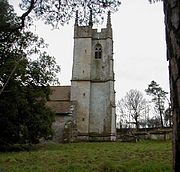
The tower of St Giles's in 2002
See main article St Giles' Church, Imber
The church is a Grade I listed building.[8]
Unlike the rest of the parish, St Giles's church and its graveyard remained in the hands of the Diocese of Salisbury, although access to them was and is controlled by the Ministry of Defence. The Bell Inn was sold to the MoD in the mid-1950s and the Baptist Chapel in the late 1970s. The civil parish of Imber was eventually incorporated into neighbouring Heytesbury, to the south, while for Church of England purposes the ecclesiastical parish of Imber was incorporated into the Edington, to the north. This combined ecclesiastical parish of Edington-with-Imber was responsible for another ancient listed church, Edington Priory, as well as St Giles's. By 2001 it had become clear, according to a Church of England press release, that St Giles's "was in need of extensive repairs." Since it was "not possible for the parochial church council to accept liability for the maintenance of a building to which they only had effective access for worship once a year", the Edington-with-Imber PCC requested that Imber church be declared redundant, setting in train a process which ended in 2005 with the vesting of the church in the Churches Conservation Trust. In the meantime, the church tower had been struck by lightning in 2003, weakening the structure, but restoration work commenced in 2008 and the annual service resumed in September 2009 on completion of the works.
The annual church service, on the Saturday nearest to St Giles Day, has been attended by former residents including Ken Mitchell (grandson of Albert Nash); the son of the last schoolmistress, John Williams; soldiers who have used the village for training, and the general public. The village is open to visitors on other occasions; generally these are certain Bank Holidays and around Christmas. From 2009 to 2012 there has been a Carol service on the Saturday before Christmas.
Census[]
Imber is still included in the census records for England. The population reached its peak of 440 persons in 1851 which had declined to 152 by 1931 when the last occupied census was taken. The next census after 1931 was in 1951 when the number of residents was listed as "0", a situation which continues to be shown on census results.[9]
Governance[]
Nearly sixty years after the removal of the villagers, the civil parish of Imber came to an end and its area was incorporated into the adjoining civil parish of Heytesbury, now referred to as "Heytesbury, Imber and Knook". Although it has no electors, Imber is represented in parliament by the member for South West Wiltshire, Andrew Murrison; and on Wiltshire Council by Christopher Newbury.
With the exception of St Giles's church, the whole parish is owned by the Ministry of Defence and is administered as part of its Salisbury Plain Training Area.
Popular culture[]
Although a somewhat obscure village, Imber has featured occasionally in printed media. This has included the novel "The Sea change" by Joanna Rossiter (Penguin)[10] which centres around the evacuation of Imber and the subsequent experiences of some fictional characters from the village in the war and post-war years.
Gallery[]
See also[]
- Tyneham — another village taken over for military purposes
- de — another village taken over for military purposes, in Germany
References[]
- ↑ "The lost village of Imber". BBC. 10 September 2010. http://www.bbc.co.uk/news/uk-politics-11345287.
- ↑ "Abandoned Communities – Imber". http://www.abandonedcommunities.co.uk/imber.html.
- ↑ The secrets of Britain's abandoned villages
- ↑ Sawyer 2001, pp. 145–152
- ↑ Sawyer 2001, pp. 158–159
- ↑ Sawyer 2001, pp. 158
- ↑ Sawyer 2001, pp. 159
- ↑ "Church of St Giles". Listed Buildings Online. http://www.heritagegateway.org.uk/Gateway/Results_Single.aspx?uid=313552&resourceID=5. Retrieved 23 September 2008.
- ↑ "Imber Census Information". Wiltshire Council. http://www.wiltshire.gov.uk/community/getcensus.php?id=139. Retrieved 13 May 2013.
- ↑ http://www.penguin.co.uk/nf/Book/BookDisplay/0,,9780241964156,00.html?strSrchSql=the+sea+change/The_Sea_Change_Joanna_Rossiter
Further reading[]
- Bodington, E.J. (1919). "The Church Survey in Wiltshire 1649–50". pp. 23–5. http://www.wiltshire.gov.uk/community/getprinted.php?id=154.
- Glanfield, Edgar (1922). "The Dew Pond Makers of Imber". pp. 73–5. http://www.wiltshire.gov.uk/community/getprinted.php?id=156.
- Kite, Edward (1920). "Imber and Imber Court". p. 212.
- Ponting, C.E. (1889). "Church of St. Giles, Imber". pp. 13–15. http://www.wiltshire.gov.uk/community/getprinted.php?id=151.
- Powell, J.U. (1918). "The Derivation of Imber". p. 362.
- Revels, G.S. (c. 1972) A Thousand years of History: a short guide to St Giles Church and the Parish of Imber.
- Sawyer, Rex (2001). Little Imber on the Down: Salisbury Plain's Ghost Village. East Knoyle: Hobnob Press. ISBN 0-946418-06-3.
External links[]
| Wikimedia Commons has media related to Imber. |
- Details of history and church openings— Information about St Giles Church Imber
- Information about access to Imber from public-interest.co.uk
- Gallery of photos of Imber from ThincTanc
- Maps and photos of the church
- Etymology of the name
- 2003 arts event at Imber
- Review of the 2003 arts event at Imber in The Times
- Imber: An English Ghost Town — slideshow by Life magazine
- Audio slideshow: The lost village of Imber — audio slideshow by the BBC.
- Wiltshire County Council. "Wiltshire Community History: Imber". Retrieved 26 May 2005.
- BBC Wiltshire Villages. "The plight of the church at Imber". Retrieved 26 May 2005.
- Imber ranges opening, August 2008. Saracontent.org.uk
The original article can be found at Imber and the edit history here.

